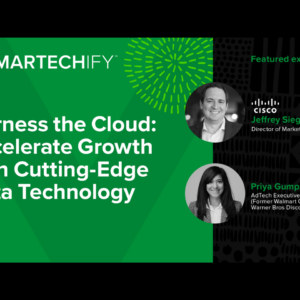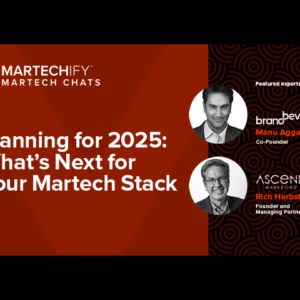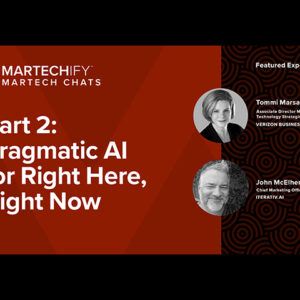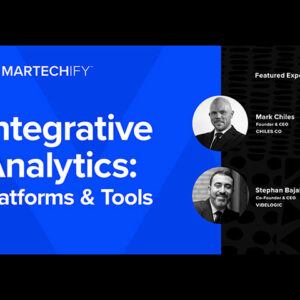Session Recap
Martech Stack Evolution: Latest Trends
February 16, 2023 – During this Martechify session, three of our martech experts gave an insider view of the latest martech trends, including use cases, valuable insight, and advice.
This lively discussion, moderated by Rich Herbst of Ascend Marketing, included Sujoy Chandra of SiriusXM; Beki Scarbrough, formerly of Demandbase; and Nitin Ahuja of Verizon.
If you missed the event, read the summary below for the key takeaways, or click below to watch the video of the entire discussion.
Featured experts
Hitting the high points: Key expert takeaways
The martech landscape seems to be changing every day—with no signs of slowing down. To make the most of their martech stack, today’s digital marketers must stay on top of the latest technology tools as they continually expand and evolve. What better way to learn how to keep up with the pace than from experts who’ve been there?
Martech evolution: The macro view
To explore the many moving parts of the martech evolution, we started the session with the major, macro level changes that are driving it. According to our experts, here are some of the most significant factors:
Martech’s impact on marketing. As martech tools become more accessible, marketing teams are pulled into tech, blurring the lines between the two. There are implications on the human part of an organization, as it must be able to absorb and adopt new tools in the continuously growing martech stack. If the stack becomes too complex, with too many moving parts, it leads to poor usage. An optimized stack must emphasize field enablement, training and upskilling to ensure the new technology is being fully utilized.
Another aspect of martech’s effect on the human side of the business is the big shift in recent years from above the line to below the line focus on marketing, causing a shift from creative and content-focused efforts to an AI, data science, and data-driven decision focus. Related to this rise of AI/ML, brand teams and marketing teams will have to be data-savvy and stay on top of all privacy requirements. As platforms and tools do more and more, there will be implications for the organization’s skillset and what functions the marketing team fills. Advances in tools demand highly-specialized skills, including architecture experts, data engineers, machine learning specialists and deep data scientists. Though it will always be important to understand the consumer story and how your organization generates value, could marketers look more like data-engineers over the next few years?
Martech stack consolidation and rationalization. Amidst an uncertain economic environment, much attention is focused on martech rationalization. With CMOs spending more on martech than on people, the pressure is on to closely assess whether or not tech capabilities are being fully utilized—and if that’s in question, marketing organizations will need to simplify their martech stacks, and focus more on specific use cases.
More and more martech gives us more and more data, but what are we doing with it? How is it all brought together? When data is underutilized or activated, it’s pointless. Marketers must integrate data from their multiple vendors—which can be 80 or more in large companies—and fully activate it across experiences to enable contextual decisions at the right moments along the journey. That makes martech consolidation and rationalization a win-win for both a profit and loss standpoint, but also towards the mission of data-driven enterprise. The question is, How do we get to that faster, and at a lower cost?
Privacy and a cookie-less future. As third-party cookies go away and data privacy needs require compliance to stricter regulations, marketing teams will need to figure out what, and how, to measure the success of their efforts. What’s not changing is the overarching marketing mission: Reach your audience at scale and deliver personalized experiences that will drive engagement and conversions.
The power of personalized experiences. The growth of personalization is powered by customer data. More than ever before, there is emerging technology that enables us to match data and insights to decisioning technologies. Thanks to these inputs, marketers can now see a customer or prospect across channels, devices and experiences, which enables optimized journeys with highly-personalized tactics, messaging and offers.
The latest martech trends, developments, and strategies for 2023 and beyond
Paid media: Positioned for growth
Gaining speed and expanding opportunities. Paid Media is an integral part of any marketing plan. It’s a very large industry and a very large spend each year – projected to reach approximately $200 billion in 2023. With that large spend, there’s opportunity to improve and optimize the investment.
Among the key projections for Paid Media in 2023 are the expectations that it will take a larger share of digital, with programmatic, and connected TV part of that expansion. Additionally, ad-supported Open Internet and consolidation of AdTech platforms (SSP, DSP) on both the publisher side and the advertiser side.
Campaigns driven by artificial intelligence and machine learning. We’re watching the expansion of AI/ML to optimize ad campaigns. For example, Meta Advantage+ Creative shows the importance of the creative side of advertising. The platform can build an ad so that it drives conversions, using components, such as headline, description, or primary text, to appeal to an individual. Images and video can be enhanced – by adjusting brightness and contrast, cropping images, adding filters, and more.
Another example is Google Performance Max, which allows one campaign to access multiple channels, including YouTube, Display, Search, Discover, Gmail, and Maps to complement search campaigns. Again, ads will be enhanced with machine learning. Google will select the best mix of the ad elements the marketing team provides, such as headlines, assets, and images, and come up with the best channel to drive conversions. Additionally, functions that performance marketing teams have been doing—like manual optimizations, bid adjustments, targeting, placements – are all automated now. The positive side is that automation “levels the playing field” because everyone has access to the same information. The downside, however, is that the platform can become a “black box” that keeps marketing removed from what actually works and why.
Preparing for a Cookie-less World. Google Universal Analytics will end in July, 2023, and that’s the time to switch to Google Analytics 4.0 (GA4). This is the new universal analytics, based on event-based architecture, and provides web and app reporting under one platform. Consider enabling Google Signals, which provides cross-device reporting by aggregating data from multiple browsers and devices with no reliance on user cookies.
2023: The year of the buying group
What is a buying group? It’s time to see individuals in the context of a larger buying group. An example of the importance of this context is General Motors (GM), which is a good template for enterprises in general. When our marketing team needs to target people within GM America who are interested in a services component—a specific set of people, it’s easy to target all GM employees and hope we land on the right buyers—easy, but not effective. Instead, we need to identify, target and measure at the buying group level, and see individuals in the context of the team they are part of, the business decisioning that they are doing as part of a buying group. We now need a very thoughtful approach on how our teams go to market and how to better connect the people who might become customers with the right content.
Vendors will shift from account based to buying group based. Multiple business units and multiple possible buyers and one marketing team and one marketing stack combine to make it difficult to measure what is effective. With today’s tech, we haven’t been able to do that. But there’s no need to go to yet another vendor to try to solve the problem. Instead, the responsibility is on the marketing team to be more clear with the vendors we already have about what we need from them, what’s standing in the way of you being able to do a great job. Help them to see outside of their own tool and consider the connections with things beyond web data and who visited—help them to see the importance of measuring the customer journey.
Automation in a land and expand world. It’s time to think beyond campaign naming conventions and data fields—it’s now down to tags, and it’s going to be down to content. Digital asset management is vital, and we have to be sure that content is not executed outside of a centrally-managed framework. That means enterprise marketing teams can no longer stay disconnected—no more working in silos. Optimizing Land and Expand requires a cohesive, intentional approach from all departments, as well as integration with CMS, DAM, and CDP. It’s a big change, but Sales and Marketing organizational models need to adapt, now, to succeed.
Innovative approaches to decisioning
Verizon Business: An industry leader in decisioning engine tools. The ecosystem of Verizon Business doesn’t fit the typical next-best-action use case. To meet the demands of its very complex set of products and very complex set of sales journeys, Verizon built and leverages a B2B-specific, B2B-grade decision engine—an engine with strong adoption and results, which powers 4.6 million interactions every month.
Decisioning-as-a-Service. The B2B sales journey is non-linear and filled with many unique interactions which can be powered by decisioning. Verizon created a dynamic proposition framework to adapt to these decisions with the same platform at the core. While most decisioning engines provide insight on the best products, pricing and promos for that buyer, Verizon’s Decisioning-as-a-Service goes a step beyond, looking at the solutions across their entire portfolio that can be sold to that account. The engine also looks at the next best moment to engage the buyer to drive a sale in that moment and determine the next best content to push that customer towards conversion.
Native experiences. The “native experiences” term refers to the ability of Verizon’s new simplified, standardized process to give new reps the same effectiveness of the experienced reps. The design philosophy is “designed by the frontline, built for the frontline”—meaning that from the design stage of the tool to concept and training, they maintain a strong partnership with their field and end users, and focus on field enablement and training. Co-ownership of the design and strong emphasis on the voice of the employee has resulted in much faster adoption rates of the tools. Along with the higher adoption rates, Verizon has seen a 10% to 20% reduction in handling time for calls to the contact centers and some store visits.
Real-time marketing & sales insights. Verizon has connected the vast amount of real-time insights with its real-time decisioning engine, allowing retargeting and remarketing much faster, near real-time at scale and empowering sales reps with real-time sales intelligence for the first time. Using customer insights from across all channels, including digital interactions, store visits and calls, reps can leverage real-time sales intelligence to react faster with personalized outreach efforts to defend and grow those accounts.
The next frontier. Live Decisioning is the next stage of the decision practice, fueled in part by significant advancements in real-time speech technology, which captures the intent of customers on the phone or within digital sessions. This progress switches the reliance on offline segmentation, which is largely based on predictive models scored in the last day to last thirty days, to leverage real-time technology to optimize the next best action and next best offer.
Hybrid Architecture is another innovation that utilizes an offline instance of the decision engine, that can focus on proactively creating next best action at scale, staging that data for large accounts while working in tandem with an online instance of the engine. Together, they can produce the right balance between scale and response time. This is a unique perspective that strives to create the perfect experience for frontline sales teams as well as customers.
Related resources
New to this topic? Find helpful external links below.
Watch the recording
For more insights and takeaways from the session, watch the full recording here:













